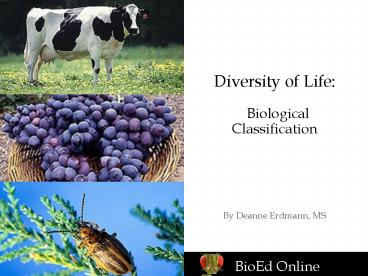Diversity of Life: Biological Classification - PowerPoint PPT Presentation
1 / 14
Title:
Diversity of Life: Biological Classification
Description:
Classification systems change with expanding knowledge about new ... 2. a) Are margins of the leaf jagged? Go to 4. b) Are margins of the leaf smooth? Go to 5 ... – PowerPoint PPT presentation
Number of Views:6832
Avg rating:3.0/5.0
Title: Diversity of Life: Biological Classification
1
Diversity of Life Biological Classification
- By Deanne Erdmann, MS
2
Why Do We Classify Organisms?
- Biologists group organisms to represent
similarities and proposed relationships. - Classification systems change with expanding
knowledge about new and well-known organisms.
Tacitus bellus
3
Taxonomy - Classification
- Binomial Nomenclature
- Two part name (Genus, species)
- Hierarchical Classification
- Seven Taxonomic Categories (Linnaeus)
- Three domains
- Systematics
- Study of the evolution of biological diversity
Leucaena leucocephala Lead tree
4
Binomial Nomenclature
- Carolus von Linnaeus
- Two-word naming system
- Genus
- Noun, Capitalized, Underlined or Italicized
- Species
- Descriptive, Lower Case, Underlined or Italicized
Carolus von Linnaeus(1707-1778) Swedish
scientist who laid the foundation for modern
taxonomy
5
Hierarchical Classification
- Taxonomic categories
- Kingdom King
- Phylum Philip
- Class Came
- Order Over
- Family For
- Genus Green
- Species Soup
6
BACTERIA
- EUBACTERIA
- Prokaryote, Cell Walls with peptidoglycan,
- Unicellular, Autotrophic or Heterotrophic.
- ARCHAEBACTERIA
- Prokaryote, Cell Walls without
- peptidoglycan, Unicellular, Autotrophic
- or Heterotrophic. They live in extreme
environments.
7
PROTISTA
- Cell walls of cellulose in some
- Some have chloroplasts
- Most unicellular some colonial
- Some multicellular
- Autotroph or Heterotroph
8
FUNGI
- Eukaryote
- Cell walls of chitin
- Most multicellular some unicellular
- Heterotroph
9
PLANTAE
- Eukaryote
- Cell walls of cellulose chloroplasts
- Multicellular
- Autotroph
10
ANIMALIA
- Eukaryote
- No cell walls or chloroplasts
- Multicellular
- Heterotroph
11
Kingdoms and Domains
The three-domain system
Bacteria
Archaea
Eukarya
The six-kingdom system
Bacteria
Archaea
Protista
Plantae
Fungi
Animalia
The traditional five-kingdom system
Monera
Protista
Plantae
Fungi
Animalia
12
SystematicsEvolutionary Classification of
Organisms
- Systematics is the study of the evolution of
biological diversity, and combines data from the
following areas. - Fossil record
- Comparative homologies
- Cladistics
- Comparative sequencing of DNA/RNA among organisms
- Molecular clocks
13
Taxonomic Diagrams
Mammals
Turtles
Lizards and Snakes
Crocodiles
Birds
Mammals
Turtles
Lizards and Snakes
Crocodiles
Birds
Cladogram
PhylogeneticTree
14
Dichotomous Keys Identify Organisms
- Dichotomous keys versus evolutionary
classification - Dichotomous keys contain pairs of contrasting
descriptions. - After each description, the key directs the user
to another pair of descriptions or identifies the
organism. - Example 1. a) Is the leaf simple? Go to 2 b)
Is the leaf compound? Go to 3 - 2. a) Are margins of the leaf jagged? Go to
4 b) Are margins of the leaf smooth? Go to 5































